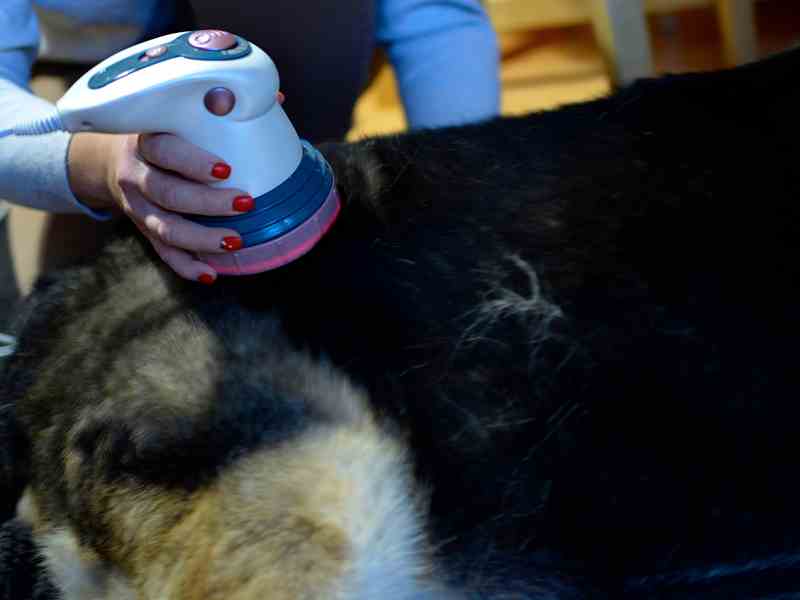Joint health issues are a common concern among dogs, because they significantly impact their quality of life. From arthritis to hip dysplasia, these conditions can lead to discomfort, reduced mobility, and a lesser ability to enjoy daily activities. Looking for ways to help those issues proactively can involve physical therapy for dogs. It can serve as a preventative and rehabilitative approach to managing and enhancing joint health in our furry friends. Physical therapy for dogs can offer relief and support long-term well-being, focusing on strengthening and flexibility to improve their overall function.
The Importance of Joint Health In Dogs
Maintaining good joint health is crucial for dogs, which is crucial in ensuring they lead active, joyful lives. Just like in humans, healthy joints in dogs mean more than just the absence of pain; they’re about mobility, flexibility, and the ability to engage in daily activities without that discomfort. Whether it’s a sprint across the park, a leisurely stroll around the block, or simply jumping up to greet you with a slobbery kiss, every one of these moments relies on healthy, functioning joints. Good joint health in dogs supports physical well-being and contributes to a positive mental state that keeps them lively, engaged, and happy.
Common Dog Joint Problems
Several conditions can compromise joint health in dogs, with arthritis and hip dysplasia being among the most typically seen. Arthritis is often seen in older dogs, and is characterized by the inflammation and degeneration of joints, leading to pain and stiffness. Hip dysplasia, a genetic condition more common in large breeds, involves an improper fit of the ball and socket in the hip joint, causing wear and tear over time that can result in arthritis or other joint issues. Other conditions that affect dog joints include ligament tears, such as CCL injuries, and patellar luxation, where the kneecap slips out of place. This is often seen in smaller breeds. Each of these conditions can significantly impact a dog’s quality of life, making it difficult for them to move freely and without pain.
Recognizing the Signs Of Joint Pain In Dogs
Recognizing the early signs of joint health issues in dogs is the key to managing their condition effectively. You may see a noticeable decrease in their activity level, or see them have difficulty standing up or lying down. You might notice they’re limping or favoring one leg, have a reluctance to climb stairs or jump, or have visible swelling around the joints. Dogs may also show signs of discomfort or pain when they’re touched in affected areas or they might be less eager to play or engage in activities they once enjoyed. Early detection and intervention can make a significant difference in managing these conditions, preventing further deterioration of joint health, and maintaining the highest possible quality of life for your furry best friend.
The Role of Physical Therapy for Dogs in Joint Health Maintenance
Physical therapy for dogs has always been a go-to for veterinarians to manage and improve their health because science has shown it to benefit them. Non-invasive ways to help your dog reduce pain and improve their quality of life are always great goals. A dog physical rehabilitation program can be beneficial for the following:
- Improvement in Joint Function: Dog therapy techniques are designed to maintain or increase the range of motion within their affected joints, which ultimately improves their function. Studies have shown that targeted exercises for dogs can help to distribute synovial fluid, which lubricates the joints, reducing friction and wear over time.
- Pain Reduction: Regular therapy sessions have significantly reduced pain in dogs with conditions like osteoarthritis. This happens through various modalities that help reduce inflammation, swelling, and the discomfort of joint degeneration.
- Enhanced Mobility: By strengthening the muscles surrounding the joints, PT for dogs provides better support for weakened areas and enhances their ability to move more freely and with less discomfort. Enhanced mobility allows them to have a more active lifestyle, which is essential for weight management and overall health.
Types of Physical Therapy Treatments For Dogs
The science behind physical therapy for dogs has led to the development of various treatment options, and each has its own set of benefits:
- Hydrotherapy: Hydrotherapy uses the resistance of water and allows dogs to engage in low-impact exercise, which is particularly helpful for those with arthritis or recovering from surgery. The buoyancy of water supports the body, reducing stress on their joints while the resistance helps them to build muscle strength. Research indicates hydrotherapy can significantly improve function and quality of life in dogs with joint issues. If you don’t have access to the type of devices used specifically for dogs, any swimming activities can provide good exercise with low-stress impact on the joints, building strong muscles without undue strain.
- Massage: Canine massage therapy helps increase circulation, promotes the removal of inflammatory by-products, and reduces muscle tension. This helps alleviate joint pain and contributes to faster recovery times after physical exertion or injury.
- Laser Therapy: Low-level laser therapy (LLLT) has been scientifically proven to promote healing, reduce inflammation, and decrease pain levels. Laser therapy enhances cellular energy production by emitting specific wavelengths of light, which in turn supports tissue repair and pain relief.


- Therapeutic Exercises: Tailored exercise programs are developed based on a dog’s specific condition and needs, focusing on strengthening muscles, improving flexibility, and maintaining or increasing the range of motion. Scientific literature supports therapeutic exercises in managing chronic conditions and improving function in dogs with joint health issues.
Beyond Physical Therapy: Diet and Nutrition for Joint Health In Dogs
A diet rich in specific nutrients can support a dog’s joint health. Foods high in omega-3 fatty acids, such as fish oils and certain plant oils, are known to have anti-inflammatory effects that can benefit joint health. Green-lipped mussels are an incredible source of glycosaminoglycans and have shown promise in some studies for improving pain and joint damage, and they may help in the repair of damaged joint tissues. Additionally, ensuring that a dog’s gut health is in good shape is crucial as it allows for better absorption of these nutrients. In turn, this supports overall health and well-being. It’s not just about the ingredients but how well your dog’s body can utilize them.
Weight Management
Maintaining a healthy weight is crucial for joint health. Excess weight puts additional stress on a dog’s joints, which can make joint issues and pain worse. A combination of a proper diet and regular exercise can help manage weight and reduce the burden on joints.
Regular Vet Check-ups
Regular check-ups with a veterinarian can help with early detection and management of joint issues. These visits can help catch early signs of joint deterioration and allow for interventions like physical therapy and nutritional supplementation, potentially slowing the progression of joint diseases like osteoarthritis.
Supplements For Dog Joints
Just as physical therapy has the goal of reducing stiffness by thoughtful manipulation of the joints to improve synovial fluid, supplemental ingredients can also support the fluidity of the joint capsule.
Physical therapies used to decrease inflammation in dogs can be supported internally by anti-inflammatory ingredients. While glucosamine and chondroitin are popular supplements for joint health, the scientific evidence supporting their efficacy at the doses commonly found in veterinary diets is really limited. However, undenatured type II collagen (UC-II) has been found in clinical and experimental studies to be effective even at smaller dosages than glucosamine and chondroitin and more effective than these common supplements at improving joint health and function in many animals, including our dogs.
The Role of Undenatured Type II Collagen In Dog Joint Health
Undenatured type II collagen (UC-II) has shown lots of promise in supporting joint health. Unlike other collagen forms that may lose their biological activity during processing, UC-II keeps its basic, native form. This form of collagen is found in the cartilage and helps maintain its integrity. A study published in the journal Animals suggested the efficacy of UC-II for joint health in dogs could be more effective than the popular duo of glucosamine and chondroitin, and better, UC-II could be in even lower doses than glucosamine/chondroitin. The research suggests that UC-II might play a role in managing conditions like osteoarthritis in dogs by possibly slowing the disease’s progression and reducing its symptoms. It’s what we were looking for when we decided to create a joint supplement for Bernie and Lady.
Joint Supplements For Dogs: Bernie’s Marvelous Mobility
We are well aware of the important tool for rehabilitation and joint maintenance physical therapy is. Our Bernie went through several different physical therapies that we found beneficial. He was showing signs of some joint weakness as a puppy, and so he did some proactive hydrotherapy and acupuncture to build functional strength. Now, his adult radiographs look better than his puppy images!
But we also learned as we consulted with more experts that daily supplementation could play a pivotal role, too. Bernie’s Marvelous Mobility was formulated with our holistic approach in mind. We wanted to blend ingredients that were based on current, science-backed evidence to support our dogs’ joint health and overall well-being. We wanted to do that for dogs everywhere.
That’s why we combined things like flaxseed, anchovy, and algal oils that are rich in omega-3 fatty acids–they have amazing anti-inflammatory properties. We also chose antioxidants like astaxanthin, sourced from microalgae, and blueberries to combat oxidative stress, and we purposely didn’t jump on the glucosamine/chondroitin bandwagon because we just didn’t want to give our dogs ingredients that science didn’t back as much. Instead, we went with undenatured type-II collagen because of all its promising results in maintaining cartilage health and joint function. We especially loved that it is shown to do this in clinical studies and at even lower doses compared to traditional supplements.
We selected every ingredient, from green-lipped mussels for their glycosaminoglycans to the anti-inflammatory properties of turmeric and the metabolic benefits of boron, because our own dogs’ health was our goal. The best part is that we can share with dog parents everywhere so they can have the best, most current science-backed ingredients for their furry family members.
Combining physical therapy with a daily supplement like Bernie’s Marvelous Mobility can provide a holistic, comprehensive approach to your dog’s joint health and ensure they have the support they need to stay active and happy for as long as possible. For us, it’s always about more than just treatments; it’s about giving our dogs the best quality of life and showing them the same love and care they unconditionally give us.

